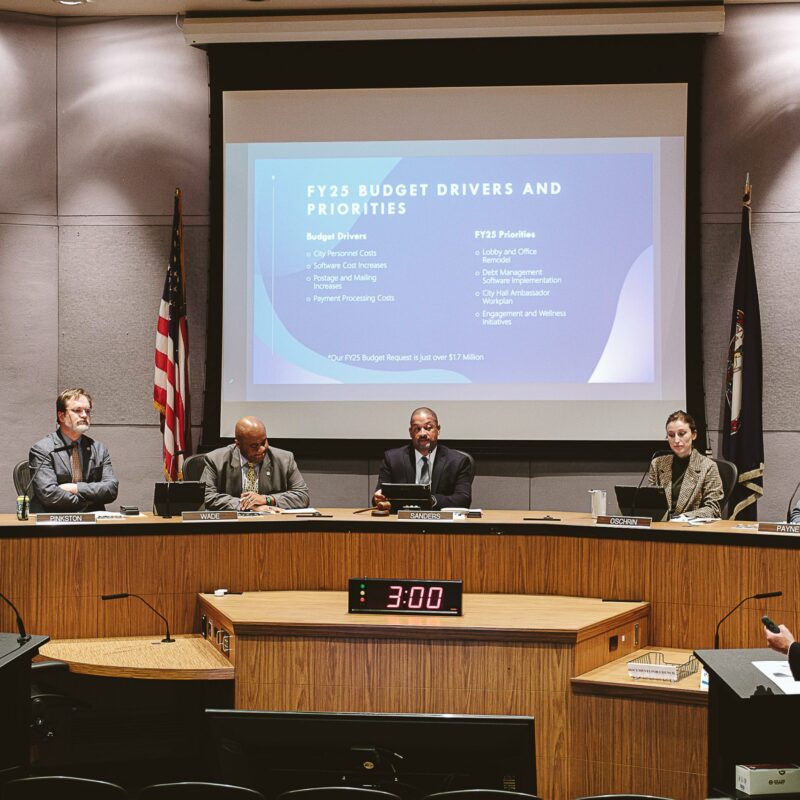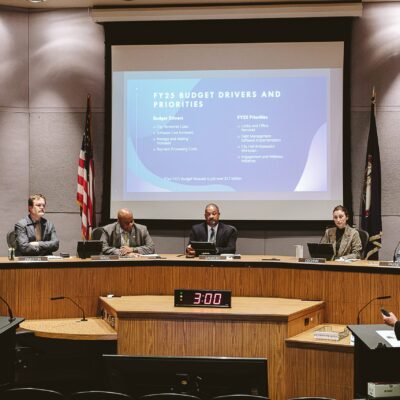Some people really love trains. Railfans they call themselves. Train buffs. What the railway workers sometimes derogatorily call foamers because they foam at the mouth when they see a train. Railfans wear t-shirts celebrating their favorite railroads, they construct elaborate model train universes in their basements, and they travel long distances just to watch the elusive beasts run. Walt Disney was a train lover, Rod Stewart and Neil Young both play with toy trains (Young was once part owner of model train company Lionel), and our vice president, old Amtrak Joe himself, was referred to by the president as “America’s Number One rail fan.” So railfans are in good company. And besides, who hasn’t, for at least one small moment in his life, loved a train?
Our story begins in the town of Dillwyn down in Buckingham County, population somewhere around 440 and consisting of basically Route 15 and a miniature brick main street. You’ve also got Cheryl’s Barber & Beauty Salon, the tiny Dillwyn Town Hall, and the train station—a gray and white building in that classic long, low, boxcar-like shape. Kind of anachronistic, train stations, but behind this one around 200 people wait on a sleepy Saturday (last Saturday, in fact) for a train to arrive. An African-American church group prays in a circle behind the port-a-potties (“They must know something about the track we don’t,” someone says), a railway safety group hands out brochures (“about 1,000 people die or are injured each year by fooling around with trains”), and a 17-year-old rail fan who’s been obsessed with trains since he was 3, climbs aboard the object of his obsession for only the third time in his life. The train rattles off like an old roller coaster, shaking side to side.
The James River Rambler is what’s known as an excursion train, a short, scenic, tourist jaunt down 16 miles of track from Dillwyn to New Canton and then back again. It’s seven cars, some built as far back as 1922, pulled by a 1,500 horsepower diesel-electric engine, Locomotive 101 that was built in the 1950s for the Richmond, Fredericksburg & Potomac Railroad. The big railroads won’t run excursion trains, mostly for liability reasons, and so trains like the Rambler are rarities, running on small, privately owned tracks, kept going for the simple reason that a lot of people really love trains.
|
Conductor Giles Scott radios to the engineer as the Rambler backs onto a bridge over the James River. |
The Rambler does not run fast (we’re talking 10-15mph) and the only real sensation of speed comes when you look straight down at the tracks through the gap between cars. We move through sleepy little Dillwyn, paralleling the highway for a while. Cars and trucks honk and people wave from their yards. The town fades into dense green woods broken up by stretches of farmland and factories. Trains, once symbols of our nation’s future, seem now to provide tours of its past. The Rambler shudders by abandoned boxcars, festooned with rust and graffiti, and the ruins of other big machines peering out of their rhododendron graveyards.
The track that runs through Dillwyn, called the Buckingham Branch, was saved from becoming a ruin itself when it was purchased in 1989 by retired railway worker Bob Bryant and his wife Annie. Built in the 1800s, the 17.3-mile short-line that runs from Dillwyn to Bremo along the James River was part of the bigger C&O Railroad and carried timber and locally mined slate to the James River where it met up with the bigger rail lines. During the consolidation and long decline of the railroads in the latter half of the 20th century, short-lines like the BB were either sold or abandoned. Ironically, many of these private railroads now run successfully while their government-sponsored brethren cannot.
The BB runs freight trains during the week, hauling the same locally produced products it always has—shale, wood chips, sand—up to meet the big CSX trains and then returning with farm and business supplies. On the weekends, Bob Bryant being one of those people who really love trains, the Old Dominion Chapter of the National Railway Historical Society uses the track to run the James River Rambler.
There are two closed cars on the Rambler, with comfy seats and A/C, but I can’t understand why people ride in them because you might as well be on an Amtrak train. The only place to be is in one of the two open cars—converted boxcars that used to haul wood pulp to West Virginia and now have open rail sides that you can lean your head over to feel the wind and see the terrain passing by. On a straight stretch, you just see the side of the car in front of you, but on a curve you get the view that the railfans are all waiting eagerly to photograph: the gentle parabola of the cars as they curve up to the engine. The brakes squeal and the hollow whistle blows. It’s part warning, part salute.
|
MIDDAY RAMBLER The James River Rambler Fare for short (1.5 hour) trips: www.odcnrhs.org |
“You seem to be really into trains,” I say to a young man gazing intently over the side of the car. “A railfan, yeah,” he replies. “For 14 years!” He has a bright yellow hat adorned with railroad pins, two cameras and a handheld scanner so he can listen to the rail workers and the dispatchers talk to each other. Nathan Hall is from Richmond and he works at Train Town Toy & Hobby in Ashland. The 17-year-old reads train magazines, visits train websites, and spends his weekends watching and photographing trains, yet this is only the third time he’s ever actually ridden on one. He just graduated from high school and hopes to work for the railroad someday like his great grandfather, a railway worker for 50 years, first as a switchman and finally as train master in Richmond. “It takes a lot of training,” Hall says, “to work for the railroad.” He doesn’t seem to notice the pun.
The apex of the ride on the Rambler occurs when the train reaches the James River at New Canton, where the Buckingham Branch ends and East Coast rail giant CSX takes over. The train pulls forward so that the track can be switched, allowing the Rambler to back out onto the bridge over the river, a bridge built on the foundations of a much older bridge washed away in 1972 by Hurricane Agnes. The train pushes its full length out over the river and pauses for 15 minutes or so, basking in the beautiful view. The James is running high and muddy from the recent rains, looking for all the world like the Mississippi that T.S. Eliot called a “strong, brown god.” The water curls quickly under the creosote-soaked wood with a pulsing whisper.
|
Engineer Freddie Kite, a 40-year veteran of the railroad business, says he and his wife “always lived where we could hear the whistle blow.” Retired since 2003, Kite operates the James River Rambler on the Buckingham Branch of track, from Dillwyn to New Canton and back again. |
So now the train returns to Dillwyn, but it doesn’t turn around, it goes in reverse pushed by the engine. Up in the locomotive, Freddie Kite, the engineer, sits half turned around in his chair and faces out the back window. I ask him if he can see much. “I’m just looking out the window,” he replies. He can only see about two cars ahead and the shadows of the other cars. The conductor, a whippet-thin man named Giles Scott who stands at the end, now beginning, of the train, handles the important navigation over the radio. Looking out the window is mostly just habit.
Kite is a soft-spoken man with a lined face and gray mustache. He sits in the engine’s cabin, a dusty metal box about the size of a big closet, far over on the right side facing an instrument panel that is almost comically small. Five levers, seven dials and a fan. Small, but frighteningly manual. This train comes from another time when high tech meant bigger and greasier. No computers or buttons here; the throttle and the brakes are both levers that Kite constantly adjusts. The image is more of a man wrestling with a difficult furnace than piloting a vehicle. Also in the cabin is Janet Trainum, her brother Jim Fink, and Jim’s grandson Jaden. Trainum, who lives near Palmyra, won the privilege of riding in the engine via a lottery drawing earlier in the day. The three of them are serious railfans. Fink, wearing a C&O Railroad shirt, devotes a whole room of his house to his model train collection. The threesome rides the Rambler three times a year, in spring, fall and at Christmas, making 4-year-old Jaden a three-year rail veteran.
“Trains always comforted me,” says Trainum, who clearly appreciates the irony of her last name. “My godfather worked for the train, I grew up on the train, we went places on the train. I just like seeing the view of the world from a train.”
|
Conductor Scott reboards the James River Rambler halfway through the three-and-a-half-hour excursion, from where the train proceeds backwards along the 16-mile track. |
“[My wife and I] moved eight times in 27 years,” Kite says, “and we always lived where we could hear the whistle blow.” Kite has been in the railroad business for 40 years, mostly as a supervising engineer. He retired early in 2003, but couldn’t keep away, and so now he works for the Buckingham Branch. “I’ve never drawn a paycheck from anybody but the railroad company,” he says. Railroad workers are known for their longevity, which Kite attributes to the pension, but I sense it’s also because most workers are themselves railfans. “I enjoy what I’m doing right this second just as much as at the beginning,” Kite says.
“I always wanted to be a train engineer,” Trainum says, “but my godfather told me ‘They don’t let girls be train engineers.’” I tell her that from what I can see it doesn’t look that hard and Kite laughs. What, I ask him, are the difficulties? He pauses for a long time, blue-grey eyes staring intently and then slowly smiles. “None, really,” he says. Just stay focused and remember that there are 190 people depending on you to stay focused. Good advice given that our country’s worst train wreck in 15 years was caused by a California engineer who was busy sending text messages. “It’s really more mentally taxing than physically,” he says, staring out the back window with one hand constantly working the brakes and the other lying on a railing. “But then, you can tell I’m exhausted,” he says with a big grin. Little Jaden is exhausted, falling asleep on his great aunt’s shoulder. But he wakes up in time to go sit in Kite’s lap and blow the whistle—whooo, whooo, whoooooo!—three mighty blasts before walking back to his window with a small grin on his face, blinking at the view of the world from a train.
Our story ends where it begins, in tiny Dillwyn, with Cheryl’s Barber & Beauty Salon, the Town Hall, and people waving at the train from their yards. Scott, the conductor, stands at the rear of the train, leather work gloves clutching his radio. Is there a more perfect ending than the view from the back of a train? There’s nowhere left to go, except out there onto those receding tracks like every villain or hero, in every movie with a train you’ve ever seen. Conductor Scott handles insurance for the railroad and has done so for 17 years, a job he took after retiring from his previous, non-train oriented career in the insurance business. He also rides as conductor on many of the Rambler runs, and I don’t ask why he chooses to spend his weekends standing at the back of a train. I don’t have to. He’s just one of those people who really loves trains.








